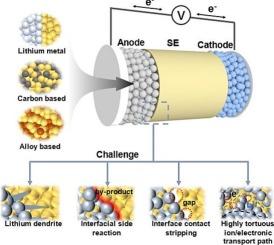Development of advanced anodes for solid-state lithium batteries
IF 22
1区 材料科学
Q1 MATERIALS SCIENCE, MULTIDISCIPLINARY
引用次数: 0
Abstract
Solid-state batteries (SSBs) may offer superior energy density, faster charging kinetics, better safety, and extended lifespan compared to conventional lithium-ion batteries that utilize flammable liquid electrolytes. These advantages position SSBs as a leading candidate for next-generation energy storage technologies, particularly in applications requiring high efficiency and safety, such as electric vehicles and renewable energy systems. At the core of SSB technology is the anode active material (AAM), which plays a crucial role in determining the battery’s energy density, cycling stability, and overall safety. This review systematically summarizes various AAMs employed in solid-state environments, encompassing a diverse range of materials, including metal-, carbon-, and alloy-based systems. Furthermore, it examines recent advancements in AAM design, focusing on innovative optimization strategies that enhance battery performance. By providing a thorough analysis of these materials and the progress made in their development, this review offers valuable insights into the future trends, opportunities, and challenges in the field of high-performance SSBs.

固态锂电池先进阳极的研制
与使用易燃液体电解质的传统锂离子电池相比,固态电池(ssb)可以提供更高的能量密度、更快的充电动力学、更好的安全性和更长的使用寿命。这些优势使ssb成为下一代储能技术的主要候选者,特别是在需要高效率和安全性的应用中,例如电动汽车和可再生能源系统。SSB技术的核心是阳极活性材料(AAM),它对电池的能量密度、循环稳定性和整体安全性起着至关重要的作用。这篇综述系统地总结了在固态环境中使用的各种aam,包括各种材料,包括金属、碳和合金基系统。此外,它还研究了AAM设计的最新进展,重点是提高电池性能的创新优化策略。通过对这些材料及其发展进展的全面分析,本综述对高性能ssb领域的未来趋势、机遇和挑战提供了有价值的见解。
本文章由计算机程序翻译,如有差异,请以英文原文为准。
求助全文
约1分钟内获得全文
求助全文
来源期刊

Materials Today
工程技术-材料科学:综合
CiteScore
36.30
自引率
1.20%
发文量
237
审稿时长
23 days
期刊介绍:
Materials Today is the leading journal in the Materials Today family, focusing on the latest and most impactful work in the materials science community. With a reputation for excellence in news and reviews, the journal has now expanded its coverage to include original research and aims to be at the forefront of the field.
We welcome comprehensive articles, short communications, and review articles from established leaders in the rapidly evolving fields of materials science and related disciplines. We strive to provide authors with rigorous peer review, fast publication, and maximum exposure for their work. While we only accept the most significant manuscripts, our speedy evaluation process ensures that there are no unnecessary publication delays.
 求助内容:
求助内容: 应助结果提醒方式:
应助结果提醒方式:


